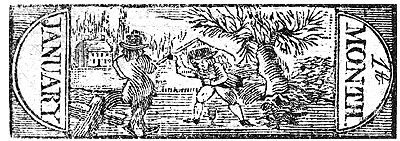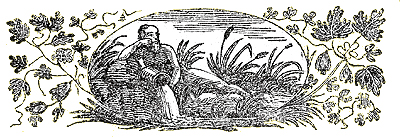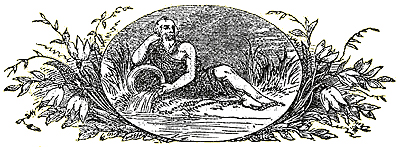The year 1800 marks the first in which the Right-Hand Calendar pages of the Almanac were illustrated — twelve different designs, one for every month.
The Calendar Pages Are Illustrated
These rectangular wood engravings, full of figures at work and play, each show a rural activity appropriate for the time of year. The cuts, used only through 1803, have a simple, primitive style and contain no initials to identify the engraver. The twelve monthly illustrations shine as energetic, enthusiastic — and to observers at a 200-year distance, exquisite — renderings of early American farm life.

The Almanac’s first calendar illustration (January, 1800) shows two boys on a frozen pond, one spinning a top.
Calendar Page Illustrations Representing the Zodiac Signs
In 1804, the monthly illustrations change from the rural to the heavenly: pictorials representing the constellations in the twelve signs of the Zodiac appear for each month. They are borderless, unsigned wood engravings that repeat (along with the Ceres frontispiece) through 1808. Interestingly, for the month of August, the engraver has depicted Virgo, the Virgin, as Ceres (or perhaps her daughter), the grain goddess, holding a sickle and bundle of wheat. Spica, the name of Virgo’s brightest star, comes from the Latin word meaning “ear of grain.”

January, 1804 calendar cut shows Aquarius, the Water Bearer.
In 1809, Robert B. Thomas, with no editorial explanation, really cleaned house. As we have seen, Alexander Anderson’s Father Time first appears on the title page in this year, and the twelve signs of the Zodiac have been re-engraved (anonymously) within ovals surrounded by decorative floral borders.

January, 1809, with a new version of Aquarius.
Different renderings of the twelve Zodiacs continue to be used at the top of the Right-Hand Calendar pages up until the present time. Along the way, remakes of the designs show up, most notably in 1819, the same year that Abel Bowen re-engraved the Father Time frontispiece (yes, the Zodiac engravings, although unsigned, strongly resemble Bowen’s style); and again in 1853, when Hammatt Billings and Henry Nichols collaborated on both the Father Time frontispiece and the Zodiac ovals.

This Aquarius by Billings appeared in 1853.
In 1979, the Zodiac engravings were replaced with assigned illustration—pen and ink drawings based loosely on the old engravings that had been used in the Almanac up to that point. In 2000, the art was changed to the engraving renderings we use today. They are engravings depicting each of the 12 months that originally appeared in the 1854 editions of Gleason’s Pictorial [Drawing Room Companion], published in Boston. We have been using these charming engravings ever since.
Part I: Title Page or Frontispiece
Part II: Right-Hand Calendar Pages (above)
Part III: Front Cover of The Old Farmer’s Almanac
Comments